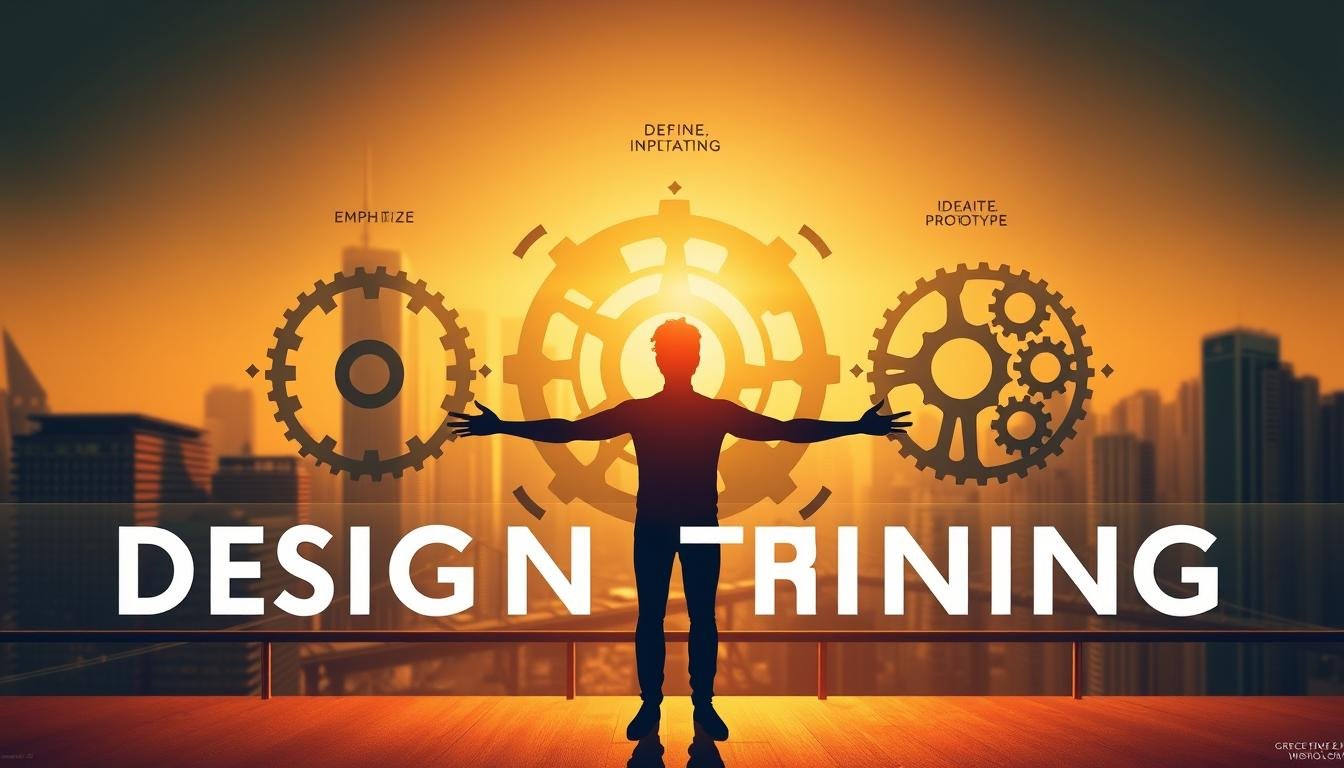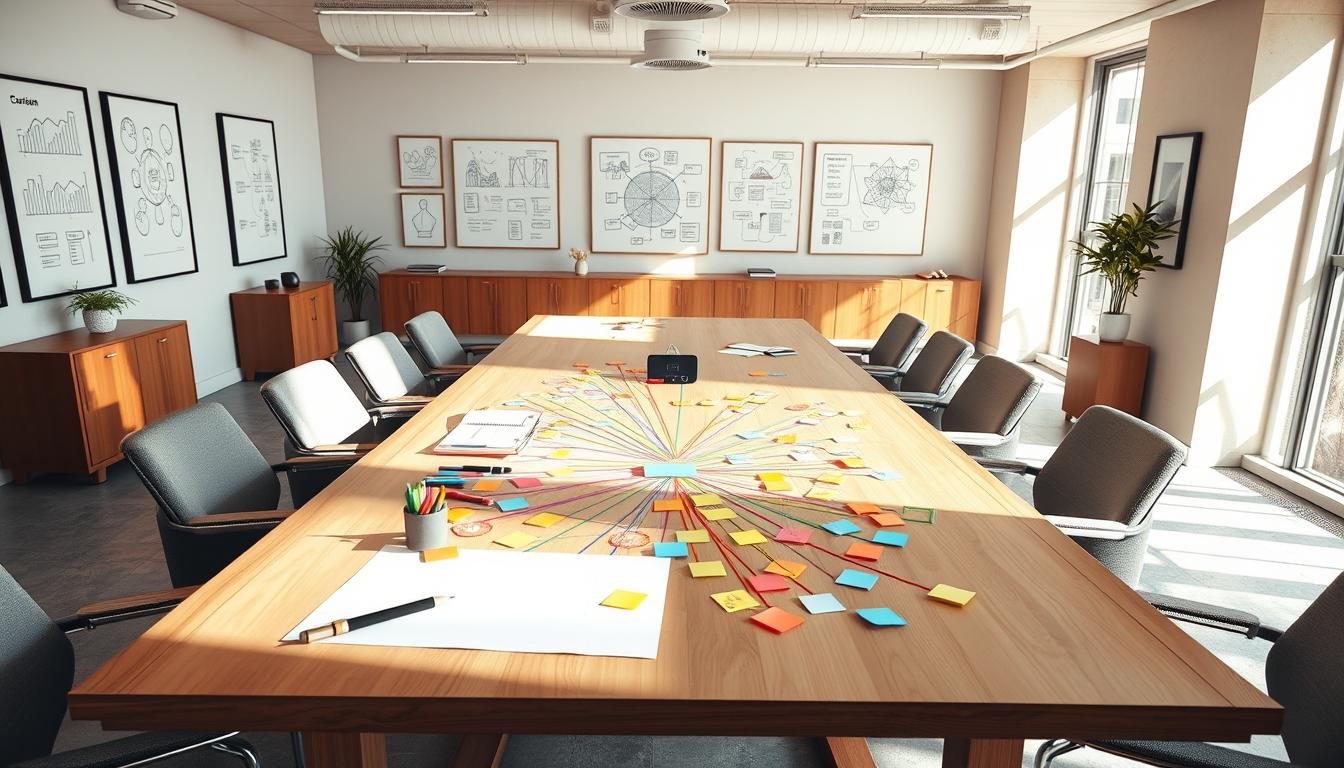Now Reading: Idea Generation: Unleash Creativity for Business Innovation
-
01
Idea Generation: Unleash Creativity for Business Innovation
Idea Generation: Unleash Creativity for Business Innovation

Idea Generation: Unleash Creativity for Business Innovation
Idea generation is more than just a buzzword. It’s the key to helping businesses stay ahead and grab new chances. In today’s fast world, companies that focus on creative thinking can turn simple ideas into game-changers. But, many still see idea creation as a lucky shot, missing its true power.
Why do some companies always lead, while others stay stuck? The secret is in their approach to idea generation. By treating creativity as a serious process, businesses can solve big problems and find what customers really want. It’s not just about quick ideas. It’s about creating systems that keep innovation flowing.

Key Takeaways
- Idea generation is a strategic process critical for adapting to market changes.
- Creative thinking directly impacts a company’s ability to produce impactful innovative ideas.
- Structured methods ensure idea generation isn’t left to chance.
- Businesses using systematic approaches gain long-term competitive advantages.
- Innovation thrives when idea generation is woven into organizational culture.
Understanding the Foundations of Idea Generation
Idea generation is key to innovation, turning ideas into solutions that grow businesses. To make the most of it, companies need to understand how creative process frameworks work with their goals. Good systems focus on quality and can be done, making sure ideas solve real problems.
What Defines Effective Idea Generation in Business
Good idea generation is more than just brainstorming. It’s a cycle of problem solving: finding gaps, testing ideas, and improving them. Companies like Apple and Google do this well, using feedback to make their ideas better. They have clear goals, involve different teams, and measure success.
Linking Idea Generation to Market Leadership
“Innovation distinguishes between a leader and a follower.” — Steve Jobs
Market leaders stay ahead by making idea generation a part of their culture. Harvard Business Review found that companies that keep improving their creative process grow 30% faster. These leaders make sure everyone can contribute, creating a culture of innovation.
Building a Sustainable Innovation Process
- Set clear innovation goals tied to business objectives
- Allocate dedicated time and resources for experimentation
- Implement feedback mechanisms to refine ideas systematically
- Document processes to ensure knowledge retention across teams
Without these steps, even great ideas can fail. A good system turns creativity into a steady problem solving machine, driving success over time.
The Role of Creativity in Business Innovation
Creativity is key to coming up with innovative ideas. It’s not just for artists; it’s a tool for businesses to solve problems and beat competitors. Companies like Google and Nike make creativity a core part of their work.
- Risk aversion limits experimental approaches
- Time constraints hinder deep exploration
- Hierarchical systems suppress employee input
Neuroscience reveals that creative thinking links imagination and logic in the brain. Leaders who use this science create spaces for unique problem-solving. For example, IDEO’s design sprints use timed brainstorming to find new solutions.
Creative thinking can be learned. Training and teamwork help teams break through mental barriers. Toyota’s Kaizen shows how a structured creative process leads to ongoing innovation. By focusing on curiosity, companies turn ideas into real strategies that change industries.
Businesses that value creativity thrive and shape markets. When teams are open to trying new things, the creative process becomes a steady source of growth. This ensures innovative ideas lead to lasting success.
Fundamental Techniques for Generating New Ideas
Creativity is key to innovation. Businesses need to know how to turn ideas into plans. Here are four ways to spark new ideas and break through creative barriers.
Brainstorming Methods That Drive Results
“Brainstorming is the process of finding a solution through the free and spontaneous association of ideas.” — Alex Osborn
Good brainstorming needs a plan. Start with clear goals and let ideas flow freely. The “6-3-5 method” helps by limiting groupthink. Companies like IDEO see a 40% boost in brainstorming thanks to timed sessions.
Mind Mapping for Complex Problem Solving
Mind maps help untangle complex problems. Start with a central idea and add keywords and colors. A 2023 MIT study showed teams using mind maps solved 30% more problems than others.
A tech firm used mind maps to find service gaps. This led to a 25% rise in product use.
Creativity Exercises to Break Mental Barriers
- Creativity exercises like “Yes, And” help build on ideas, not tear them down.
- Random word prompts can spark new ideas. For example, “cloud” might inspire new solutions for logistics.
Reverse Thinking and Constraint-Based Ideation
Reverse your goals to find new solutions. Instead of “increase sales,” think “reduce customer satisfaction.” This can uncover new opportunities.
Limiting resources like budget or time can lead to creative solutions. Google’s “20% time” policy led to Gmail and AdSense.
Creating an Environment That Fosters Innovation

A workspace that encourages creativity is more than just open desks and bright colors. It’s about creating a space where employees can freely explorecreative thinkingand bring innovative ideas to life. The right environment removes obstacles to experimentation, supporting thecreative process.
Physical Space Considerations for Creative Thinking
- Flexible layouts with collaborative zones and quiet areas boost idea flow.
- Natural light and ergonomic furniture improve focus and energy levels.
- Visual stimuli like art or nature elements spark curiosity in brainstorming sessions.
Building Psychological Safety for Risk-Taking
“Psychological safety is a belief that one will not be punished or embarrassed for speaking up.” – Amy Edmondson, Harvard Business School
Leaders can create a safe space by being open themselves. Holding “idea labs” where all ideas are heard without judgment encourages sharing. Being open about past failures helps reduce fear of being judged.
Management Practices That Encourage Experimentation
Good leadership focuses on learning over being perfect. Here are some strategies:
- Set aside time for exploratory projects (e.g., 10% of work hours).
- Recognize effort as well as results to encourage trial-and-error.
- Share “near-misses” as learning opportunities.
By combining the right physical space, trust, and support, teams can turn ideas into real innovations.
How to Contemplate Business Challenges Effectively
Effective problem solving starts with careful thought—taking a step back to really understand challenges. Many businesses jump straight to solutions, missing the key step of defining problems correctly. This mistake limits idea generation and hinders creative thinking from the start.
“Innovation comes from the patient unraveling of assumptions.” — Design Thinking Framework
Three frameworks help in deep contemplation:
- Problem Framing: Uncover hidden aspects of challenges by asking, “What if the opposite were true?”
- First-Principles Analysis: Break down ideas to basic truths, like Elon Musk did with electric vehicles.
- Systems Mapping: Show how different parts work together using tools like SWOT analysis for today’s markets.
Common obstacles to deep thinking include:
| Barrier | Solution |
|---|---|
| Information overload | Try 15-minute “focus sprints” |
| Action bias | Make time for “contemplation hours” each week |
| Continuous partial attention | Use digital detox tools in strategic meetings |
Toyota’s Kaizen approach shows that careful reflection boosts problem-solving. Setting aside time for detailed analysis helps teams tackle the real issues, turning challenges into opportunities for creative thinking.
Facilitating Productive Dialogue for Collaborative Ideation
Good creative process results come from how teams talk in brainstorming. Making sure everyone gets a say turns random thoughts into real plans. Tools like dialogue mapping and conversation design help teams understand each other better.
Structured Conversation Techniques for Teams
Teams get big ideas with methods like brainstorming techniques. Using timed rounds, like in Liberating Structures, makes sure everyone gets a chance to speak. Dialogue mapping and conversation design keep ideas flowing and diverse.
Cross-Functional Collaboration Strategies
- Put together teams with people from R&D, marketing, and operations to mix up the skills.
- Use tools like design thinking lexicons to make sure everyone understands each other.
- Let different people lead the conversation to make sure everyone has a say.
Overcoming Communication Barriers
Things like fear of being judged can stop people from sharing. Using anonymous idea boards and “idea blitz” sessions helps. A 2023 MIT study showed that taking breaks between talks can increase idea generation by 34% in tech.
“Diverse teams outperform homogeneous groups when communication is intentionally designed.” – Harvard Business Review
Formulating and Refining Raw Concepts into Viable Solutions
Turning raw concepts into real strategies needs a structured problem solving approach. Teams must mix creativity with practicality. This ensures idea generation leads to real results.
- Use business model canvases to map value propositions and customer needs.
- Prototype rapidly using low-cost materials to test assumptions quickly.
- Apply iterative feedback loops to adjust solutions based on real-world data.
“Innovation distinguishes between a leader and a follower.” – Steve Jobs
Effective formulation begins with documenting each concept’s core elements. Teams should outline objectives, target markets, and resources needed early. Tools like SWOT analysis help spot strengths and risks.
It’s important to evaluate ideas critically but not to stop creativity. Instead, it refines ideas by making them feasible without losing originality.
Stakeholders are key: they validate ideas and keep the momentum going. Prototyping turns abstract ideas into something you can test. For example, tech startups use agile prototyping to improve designs based on user feedback.
Successful refinement relies on two things: iterative testing and cross-functional input. This ensures solutions meet business goals and market needs.
Workshop Methods to Transform Ideas into Strategic Plans
Workshops turn abstract ideas into real plans. They use brainstorming methods and clear steps to make ideas work. This way, teams create plans that meet business goals. Workshops mix creativity with clear goals, so every idea gets a chance.

Design thinking workshops focus on what users need. Teams use creativity exercises like empathy mapping to find out what customers want. They then test ideas in prototyping sessions, making changes based on feedback.
Agile frameworks help move things fast with short, focused sessions. Key steps include:
- Setting clear objectives for each session
- Using rapid prototyping to test feasibility
- Assigning action items before adjourning
Keeping track of progress is important. Digital tools like Trello or Miro help track what’s done and who’s doing it. After the meeting, a summary outlines what to do next. This keeps ideas alive and connected to business goals.
Good workshops need preparation. This includes briefings before, a mix of people, and clear plans. By combining brainstorming methods with action, workshops drive growth.
Filtering Down and Selecting the Most Promising Ideas
Choosing the best ideas from brainstorming needs a clear plan. Teams must weigh the number of ideas against what’s practical. It’s important to avoid biases like favoring what’s familiar or popular.
Using tools like weighted scoring matrices helps compare ideas fairly. These tools look at how feasible, impactful, and aligned with goals each idea is. It’s key to not pick ideas just because they’re trendy or from certain people.
- Anonymous voting reduces bias in brainstorming techniques.
- Rotate evaluators to prevent personal preferences.
- Pilot tests validate assumptions before full-scale investment.
Politics can influence choices. To avoid this, set clear criteria early on. Training managers to rely on data keeps things fair. Regular checks on how ideas are chosen improve the pipeline, directing resources to the most promising ideas.
“The key to selection is not finding the perfect idea but eliminating the least viable ones.” – David Ogilvy
Good filtering mixes analysis with creativity. This way, great ideas aren’t lost too soon, and focus is on big opportunities. Being open about criteria and testing ideas helps turn ideas into real plans without killing creativity.
Conclusion
Mastering idea generation is crucial in today’s competitive markets. We’ve discussed various strategies, from structured brainstorming to agile workshops. These methods help turn raw ideas into real solutions.
Organizations that focus on creative thinking create systems where new ideas flow easily. This allows teams to face challenges with new ideas.
To use these methods, we must overcome barriers like fear of failure or strict workflows. Leaders should create spaces where trying new things is encouraged. This way, every employee can help bring in new ideas.
New trends, like AI tools for idea generation and sustainable frameworks, show how businesses can improve their creative thinking.
Starting small can lead to big wins. Teams can start by using one new technique, like design thinking workshops. Or, they can change how they give and receive feedback to value different opinions.
The journey to becoming an innovation leader begins with understanding idea generation as a skill. By using these strategies, businesses can stay ahead and grow in a changing world.
FAQ
Q: What is idea generation, and why is it important for businesses?
A: Idea generation is about creating, developing, and sharing new ideas. It’s key for businesses because it sparks innovation. It also helps solve problems and gives them an edge in a fast-changing market.
Q: What are some effective brainstorming techniques for idea generation?
A: Good brainstorming techniques include structured sessions, mind mapping, and creativity exercises. These methods spark diverse thinking. They help get past common blocks to idea generation.
Q: How can organizations foster a culture of creativity?
A: To foster creativity, ensure a safe space for ideas. Encourage trying new things and design spaces that spark creativity. Leadership that values innovation is also crucial.
Q: What role does contemplation play in problem-solving?
A: Contemplation lets people deeply think about challenges instead of acting quickly. It helps understand problems fully. This leads to better and more innovative solutions.
Q: How can teams facilitate productive dialogue for collaborative ideation?
A: For productive dialogue, use structured conversation methods. Encourage teamwork and overcome barriers to sharing ideas. This way, everyone works together to create new concepts.
Q: What techniques are essential for refining raw ideas into actionable solutions?
A: To refine ideas, use documentation, evaluation methods, and engage stakeholders. These steps keep the creative process strong while adding structure for action.
Q: How can workshops be used to transform ideas into strategic plans?
A: Workshops can use design thinking and agile ideation to turn ideas into plans. Documenting results and ensuring follow-up is key to keep momentum going.
Q: What is the process for filtering and selecting promising ideas?
A: Filtering ideas means understanding biases, using decision frameworks, and working together to evaluate them fairly. This ensures resources go to the best ideas.






























